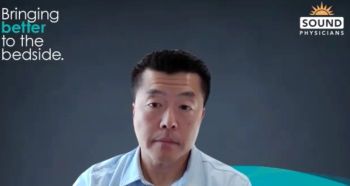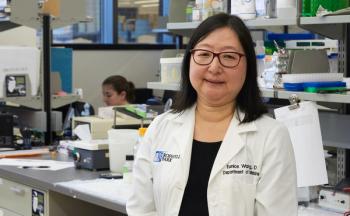
D-VRd Boosts MRD Negativity in Transplant-Eligible Multiple Myeloma
The FDA approved the quadruplet regimen on July 30 for induction and consolidation therapies in patients with newly diagnoses multiple myeloma who are eligible for autologous stem cell transplant.
This article recently appeared
Treatment with the combination of subcutaneous daratumumab (Darzalex; Johnson & Johnson), bortezomib (Velcade; Millennium/Takeda), lenalidomide (Revlimid; Celgene), and dexamethasone (D-VRd), followed by autologous stem cell transplant (ASCT), D-VRd consolidation, and daratumumab plus lenalidomide (DR) maintenance led to improved rates of sustained minimal residual disease (MRD) negativity vs VRd induction, ASCT, VRd consolidation, and lenalidomide maintenance in transplant-eligible patients with newly diagnosed
Findings presented at the 2024 SOHO Annual Meeting showed that among patients in the D-VRd arm (n = 355), 57.5% were MRD negative at a 10-5 sensitivity at the end of consolidation vs 32.5% of patients in the VRd arm (n = 354). In the experimental arm, the MRD-negative rates at the 10-5 threshold at up to 12, 24, and 36 were 65.1%, 72.1%, and 74.6%, respectively. These respective rates were 38.7%, 44.9%, and 46.9% in the control arm.
At a 10-6 sensitivity, the MRD-negativity rates in the D-VRd arm at the end of consolidation and up to 12, 24, and36 months were 34.4%, 43.9%, 57.7%, and 63.9%, respectively. In the VRd arm, these respective rates were 16.1%, 20.9%, 27.4%, and 30.8%.
Furthermore, 64.8% of patients in the D-VRd group sustained MRD negativity at the 10-5 threshold for at least 12 months compared with 29.7% of patients in VRd arm. The rates of patients who sustained MRD negativity for at least 18 months at 10-5 were 59.4% and 25.1%, respectively. At a 10-6 sensitivity, 47.3% of patients in the D-VRd arm sustained MRD negativity for at least 12 months vs 18.6% of patients in the VRd arm. The respective rates of patients who sustained MRD negativity for at least 18 months in these arms were 42% and 15%.
“These data further highlight the benefit of D-VRd and DR maintenance as a new standard of care for transplant-eligible patients with newly diagnosed multiple myeloma,” study author Meletios A. Dimopoulos, MD, professor and chairman of the Department of Clinical Therapeutics at the National and Kapodistrian University of Athens School of Medicine in Greece, said during the presentation.
A New Treatment Option for Transplant-Eligible, Newly Diagnosed Myeloma
On July 30, 2024,
PERSEUS Design and Goals
The phase 3 study included patients 18 to 70 years of age with newly diagnosed MM who were eligible for ASCT. Patients were required to have an Eastern Cooperative Oncology Group performance status of 0 to 2.
Patients were randomly assigned 1:1 prior to the start of induction therapy. In the control arm, patients received VRd consisting of 1.3 mg/m2 of subcutaneous bortezomib on days 1, 4, 8, and 11; 25 mg of oral lenalidomide on days 1 to 21; and 40 mg of dexamethasone on days 1 to 4 and 9 to 12 as induction prior to ASCT. Those in the experimental arm received 1800 mg of subcutaneous daratumumab weekly for cycles 1 and 2 and every 2 weeks for cycles 3 and 4 plus the same VRd regimen prior to transplant. Induction therapy was given for four 28-day cycles. After ASCT, D-VRd or VRd were administered at the same dosages for 2 additional cycles.
During maintenance, patients in the control arm received 10-mg lenalidomide daily until disease progression. In the experimental arm, maintenance therapy was based on MRD status; all patients initially received 1800 mg of daratumumab once every 4 weeks plus 10 mg of lenalidomide per day for a minimum of 2 years. Patients who were MRD positive continued DR. Those who were MRD negative for at least 12 months and achieved a complete response (CR) or better continued with lenalidomide alone; they were permitted to restart daratumumab if they lost their CR without progressive disease or became MRD positive.
PFS served as the trial’s primary end point. Secondary end points included overall CR or better, overall MRD-negativity rate, and overall survival (OS).
Additional Updated Data from PERSEUS
Subgroup analyses showed that D-VRd improved MRD-negativity rates and sustained MRD-negativity rates compared with VRd across prespecified subgroups.
The overall stringent CR (sCR), CR, very good partial response (VGPR), and PR rates in the D-VRd arm were 69.3%, 18.6%, 7.3%, and 1.4%, respectively. These respective rates were 44.6%, 25.4%, 19.2%, and 4.5% in the control arm. The CR or better rate was 87.9% in the D-VRd arm vs 70.1% in the VRd arm.
In the D-VRd arm, the respective sCR, CR, VGPR, and PR rates at the end of induction were 9.6%, 13.0%, 62.3%, and 9.3%. After ASCT, the corresponding rates were 10.7%, 17.2%, 57.5%, and 8.7%. At the end of induction, the sCR, CR, VGPR, and PR rates were 18.9%, 25.6%, 46.5%, and 4.2%, respectively.
For the VRd arm, the sCR, CR, VGPR, and PR rates at the end of induction were 7.1%, 14.1%, 51.4%, and 18.1%, respectively. After ASCT, these rates were 8.2%, 15.3%, 50.0%, and 17.5%. Following consolidation, the sCR, CR, VGPR, and PR rates were 13.0%, 21.8%, 47.5%, and 9.9%.
Among patients with high-risk disease, those treated with D-VRd (n = 76) achieved an MRD-negativity rate of 68.4% at the 10-5 threshold and 57.9% at the 10-6 threshold. Those rates were 47.4% and 30.8%, respectively, among patients with high-risk disease in the VRd arm (n = 78). In the experimental arm, 48.7% of patients maintained MRD negativity at a 10-5 sensitivity for at least 12 months, and 30.3% remained MRD negative at the 10-6 threshold for at least 12 months. Those respective rates were 25.6% and 14.1% in the control arm.
D-VRd (n = 44) also trended toward improved PFS among patients with high-risk disease who achieved MRD negativity at a 10-6 sensitivity compared with those treated with VRd (n = 24; HR, 0.62; 95% CI, 0.21-1.84; P = .3853).
Among patients in the D-VRd arm who were MRD positive at the end of consolidation (n = 88), 60.2% became MRD negative at the 10-5 threshold during maintenance compared with 40.5% of patients treated with VRd (n = 121; P = .0049). At the 10-6 threshold, these rates were 56.7% for D-VRd (n = 134) and 25.2% for VRd (n = 155; P < .0001). Among patients who became MRD negative at a 10-5 sensitivity, 38.6% in the D-VRd arm had sustained MRD negativity vs 17.4% in the control arm (P = .0006). At the 10-6 sensitivity, these respective rates were 31.3% and 10.3% (P < .0001).
Reaching MRD negativity at a 10-6 sensitivity was associated with improved long-term outcomes in both arms. Overall, 65.1% of patients in the D-VRd arm reached MRD negativity at the 10-6 threshold at any point compared with 32.2% of patients in the VRd arm.
“The percentage of patients achieving MRD negativity with D-VRd was significantly higher. This again speaks in favor of administering [D-VRd] up front in order to increase the number of patients who will achieve MRD negativity, sustained MRD negativity, improved PFS, and hopefully, improved OS,” Dimopoulos concluded.
References
1. Sonneveld P, Moreau P, Dimopoulos MA, et al. Daratumumab + bortezomib/lenalidomide/dexamethasone in transplant-eligible patients with newly diagnosed multiple myeloma: analysis of minimal residual disease in the phase 3 PERSEUS study. Presented at: 2024 SOHO Annual Meeting; September 4-7; Houston, TX. Abstract MM-355.
2. FDA approves daratumumab and hyaluronidase-fihj with bortezomib, lenalidomide, and dexamethasone for multiple myeloma. FDA. July 30, 2024. Accessed September 6, 2024.
Newsletter
Stay ahead of policy, cost, and value—subscribe to AJMC for expert insights at the intersection of clinical care and health economics.









































